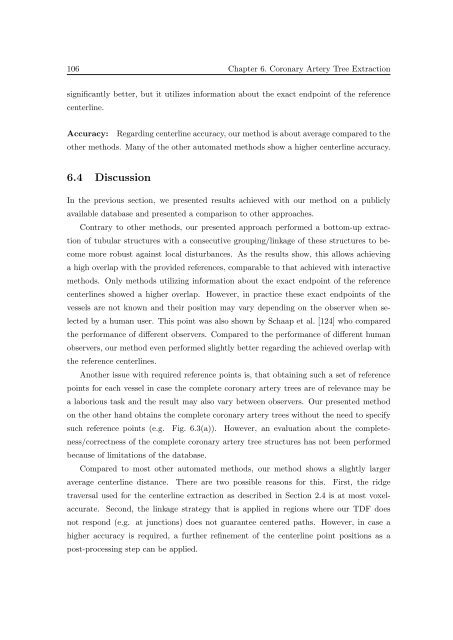Segmentation of 3D Tubular Tree Structures in Medical Images ...
Segmentation of 3D Tubular Tree Structures in Medical Images ...
Segmentation of 3D Tubular Tree Structures in Medical Images ...
You also want an ePaper? Increase the reach of your titles
YUMPU automatically turns print PDFs into web optimized ePapers that Google loves.
106 Chapter 6. Coronary Artery <strong>Tree</strong> Extraction<br />
significantly better, but it utilizes <strong>in</strong>formation about the exact endpo<strong>in</strong>t <strong>of</strong> the reference<br />
centerl<strong>in</strong>e.<br />
Accuracy:<br />
Regard<strong>in</strong>g centerl<strong>in</strong>e accuracy, our method is about average compared to the<br />
other methods. Many <strong>of</strong> the other automated methods show a higher centerl<strong>in</strong>e accuracy.<br />
6.4 Discussion<br />
In the previous section, we presented results achieved with our method on a publicly<br />
available database and presented a comparison to other approaches.<br />
Contrary to other methods, our presented approach performed a bottom-up extraction<br />
<strong>of</strong> tubular structures with a consecutive group<strong>in</strong>g/l<strong>in</strong>kage <strong>of</strong> these structures to become<br />
more robust aga<strong>in</strong>st local disturbances. As the results show, this allows achiev<strong>in</strong>g<br />
a high overlap with the provided references, comparable to that achieved with <strong>in</strong>teractive<br />
methods. Only methods utiliz<strong>in</strong>g <strong>in</strong>formation about the exact endpo<strong>in</strong>t <strong>of</strong> the reference<br />
centerl<strong>in</strong>es showed a higher overlap. However, <strong>in</strong> practice these exact endpo<strong>in</strong>ts <strong>of</strong> the<br />
vessels are not known and their position may vary depend<strong>in</strong>g on the observer when selected<br />
by a human user. This po<strong>in</strong>t was also shown by Schaap et al. [124] who compared<br />
the performance <strong>of</strong> different observers. Compared to the performance <strong>of</strong> different human<br />
observers, our method even performed slightly better regard<strong>in</strong>g the achieved overlap with<br />
the reference centerl<strong>in</strong>es.<br />
Another issue with required reference po<strong>in</strong>ts is, that obta<strong>in</strong><strong>in</strong>g such a set <strong>of</strong> reference<br />
po<strong>in</strong>ts for each vessel <strong>in</strong> case the complete coronary artery trees are <strong>of</strong> relevance may be<br />
a laborious task and the result may also vary between observers. Our presented method<br />
on the other hand obta<strong>in</strong>s the complete coronary artery trees without the need to specify<br />
such reference po<strong>in</strong>ts (e.g. Fig. 6.3(a)). However, an evaluation about the completeness/correctness<br />
<strong>of</strong> the complete coronary artery tree structures has not been performed<br />
because <strong>of</strong> limitations <strong>of</strong> the database.<br />
Compared to most other automated methods, our method shows a slightly larger<br />
average centerl<strong>in</strong>e distance. There are two possible reasons for this. First, the ridge<br />
traversal used for the centerl<strong>in</strong>e extraction as described <strong>in</strong> Section 2.4 is at most voxelaccurate.<br />
Second, the l<strong>in</strong>kage strategy that is applied <strong>in</strong> regions where our TDF does<br />
not respond (e.g. at junctions) does not guarantee centered paths. However, <strong>in</strong> case a<br />
higher accuracy is required, a further ref<strong>in</strong>ement <strong>of</strong> the centerl<strong>in</strong>e po<strong>in</strong>t positions as a<br />
post-process<strong>in</strong>g step can be applied.















